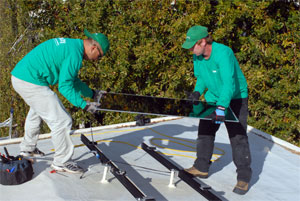 El Segundo, Calif., August 8, 2011—Blessed with abundant sunshine and a supportive political structure, California is positioned to add 7.5 gigawatts (GW) of installed power from photovoltaic (PV) sources during the period of 2010 to 2015, further ensuring that the state remains America’s leading light in solar energy, according to new insights from the IHS iSuppli Photovoltaic Service from information and analysis provider IHS (NYSE: IHS).
El Segundo, Calif., August 8, 2011—Blessed with abundant sunshine and a supportive political structure, California is positioned to add 7.5 gigawatts (GW) of installed power from photovoltaic (PV) sources during the period of 2010 to 2015, further ensuring that the state remains America’s leading light in solar energy, according to new insights from the IHS iSuppli Photovoltaic Service from information and analysis provider IHS (NYSE: IHS).
Installed PV capacity in California is projected to reach 967 megawatts (MW) this year, the highest in the country and part of an increasing push by the most populous U.S. state to derive a greater portion of energy from renewable sources, a mix that also would include wind turbines and fuel cells.
Next year, power from solar sources will generate some 1.2GW in California—more than the PV capacity of the next six-highest states combined. States approaching the land size of California, like New Mexico and Arizona, are projected to have less than a third as much PV capacity by the same time, hovering in the mid-300MW range. And outside of the top 10 states where solar generation will be highest, combined PV capacity from the lowest 40 states will add up to just 395MW, also merely one-third of California capacity, IHS data shows.
“California is indeed at the forefront of photovoltaic technology, and its commitment to the industry is important for the whole North America region,” said Mike Sheppard, analyst for photovoltaics at IHS.
California’s drive to attain clean energy gained fresh impetus during a recent two-day conference in late July at the University of California in Los Angeles (UCLA), attended by 200 researchers, academics, business leaders and politicians. There, Calif. Governor Jerry Brown reiterated the push to obtain by 2020 as much as 33 percent of energy from renewable sources, an amount equivalent to 12GW—enough to power roughly three million homes.
With a series of intensive solar projects under way, as much as 7.5GW in PV capacity could be added to the local power grid by 2015, more than half the state’s announced goal of achieving 12GW from all renewable sources—and with five more years to spare before the targeted 2020 deadline. What this shows is the likelihood of PV accounting in the future for a great portion of clean energy in California, Sheppard noted.
The figure below shows the cumulative PV capacity for California from 2010 to 2015. Given an installed PV power capacity of 900MW in 2010 that then rises to a forecast level of 8.4GW in 2015, a total of 7.5GW in power will have been added to the state in the span of five years.

California’s natural advantage lends itself to busy PV activity within the state
In the United States, California has among the highest insolation levels for measuring the rate of solar radiation delivery as measured by NASA. With a score of 5.4 kilowatt-hours per square meter per day (kWh/(m2/day)), the Los Angeles area ranks second only to the 5.96 kWh/(m2/day) rate of Honolulu, Hawaii. Los Angeles also places higher than perennial hot-weather spots like Phoenix, Ariz. (5.38 kWh/(m2/day)); Las Vegas, Nev. (5.3 kWh/(m2/day)); and Miami, Fla. (5.26 kWh/(m2/day)).
Two other areas surveyed in California likewise boast of above-average insolation rates: the Bay area near San Francisco at 5.08 kWh/(m2/day), and San Francisco proper at 4.89 kWh/(m2/day).
Aside from an inherent natural resource in plentiful supply, California hosts a number of companies engaged in the solar business, including research and development sites that do not engage in manufacturing. At least 27 firms can be found in the state engaged in solar-related activities including the production of ingots, crystalline silicon cells and modules, and thin-film cells and modules—all components that go into the manufacture of solar panels.
Currently the biggest PV project within the state is the Topaz Solar farm, a 550MW power plant being built by Arizona-based First Solar Inc., located in the Carrizo Plain northwest of Los Angeles. Other solar projects under way or slated to begin are the 55MW Niland Project in Imperial County; a five-year program by Pacific Gas and Electric Co. (PG&E) to develop 500MW of power in northern and central California; the Catalina Solar Project in Kern County; and a project by Southern California Edison for distributed power through commercial rooftops, IHS data shows.
Political patronage a plus, but state budget woes could be a challenge
Adding to California’s built-in advantages for PV power, the state has the good fortune to enjoy the backing of a highly motivated political infrastructure.
“Having sustained political will toward the achievement of renewable energy is definitely a good thing for California, and a strong political will is an encouraging sign for investors to go ahead and make their bets here in the state,” said analyst Sheppard.
California’s continuing experience in the PV field also could work to the state’s benefit, especially if it can find a way to convert its expertise into consultancy projects for other states, similar to what Germany—the world’s foremost photovoltaic market and authority—is doing in Europe. At home, California is ahead of other states in the learning curve for solar-power-generation, and the local state power utilities also have been helpful in setting up programs to help renewable energy efforts.
What could stand in the way, however, of the state making even greater progress, Sheppard remarked, could be the state’s much-belabored budget woes, which if unresolved could lead to a downgrading of the state’s creditworthiness and make it more expensive for companies—including PV firms—to do business here.
Another possible area for improvement is the current system of permits in the state to obtain PV power to streamline bureaucracy. For instance, a consumer who discovers that a PV panel supplier has run out of stock would have to restart the application process instead of- simply attaching an amendment, as is the practice in the rationalized German market.
California’s PV prospects also could encounter resistance from the local populace—an issue underscored by Gov. Brown at the UCLA event. With 58 counties and more than 400 cities in the state, selling the idea of renewable or solar power might run into opposition from residents for any number of reasons, with the potential to slow down planned rollouts or deployments.
 Alternative Energy HQ solar power for homes, wind energy, and bio fuel issues
Alternative Energy HQ solar power for homes, wind energy, and bio fuel issues





